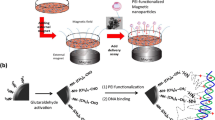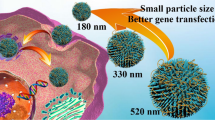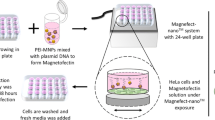ABSTRACT
Purpose
To optimize silica-iron oxide magnetic nanoparticles with surface phosphonate groups decorated with 25-kD branched polyethylenimine (PEI) for gene delivery.
Methods
Surface composition, charge, colloidal stabilities, associations with adenovirus, magneto-tranduction efficiencies, cell internalizations, in vitro toxicities and MRI relaxivities were tested for the particles decorated with varying amounts of PEI.
Results
Moderate PEI-decoration of MNPs results in charge reversal and destabilization. Analysis of space and time resolved concentration changes during centrifugation clearly revealed that at >5% PEI loading flocculation gradually decreases and sufficient stabilization is achieved at >10%. The association with adenovirus occurred efficiently at levels over 5% PEI, resulting in the complexes stable in 50% FCS at a PEI-to-iron w/w ratio of ≥7%; the maximum magneto-transduction efficiency was achieved at 9–12% PEI. Primary silica iron oxide nanoparticles and those with 11.5% PEI demonstrated excellent r2* relaxivity values (>600 s−1(mM Fe)−1) for the free and cell-internalized particles.
Conclusions
Surface decoration of the silica-iron oxide nanoparticles with a PEI-to-iron w/w ratio of 10-12% yields stable aqueous suspensions, allows for efficient viral gene delivery and labeled cell detection by MRI.










Similar content being viewed by others
Abbreviations
- ATCC:
-
American Type Culture Collection
- DMEM:
-
Dulbecco’s modified Eagle’s medium
- EDTA:
-
Ethylenediaminetetraacetic acid
- FCS:
-
fetal calf serum
- ME-FFE:
-
multi-echo gradient echo
- MNP:
-
magnetic nanoparticles
- mPDAC:
-
mouse pancreatic ductal adenocarcinoma
- MRI:
-
magnetic resonance imaging
- PBS:
-
Dulbecco’s phosphate buffered saline
- PEI:
-
polyethylenimine
- SIO-MNP:
-
silica-iron oxide magnetic nanoparticle
- SiOx :
-
silica-like coating of the iron oxide nanoparticles
- TEM:
-
Transmission Electron Microscopy
- TEOS:
-
tetraethyl orthosilicate
- THPMP:
-
3-(trihydroxysilyl) propylmethylphosphonate
- TU:
-
transducing units
- VP:
-
virus particle
- XPS:
-
X-ray photoelectron spectroscopy
REFERENCES
Plank C, Zelphati O, Mykhaylyk O. Magnetically enhanced nucleic acid delivery. Ten years of magnetofection-Progress and prospects. Adv Drug Deliv Rev. 2011; 63:1300–31.
Hughes C, Galea-Lauri J, Farzaneh F, Darling D. Streptavidin paramagnetic particles provide a choice of three affinity-based capture and magnetic concentration strategies for retroviral vectors. Mol Ther. 2001;3:623–30.
Mah C, Fraites JTJ, Zolotukhin I, Song S, Flotte TR, Dobson J, Batich C, Byrne BJ. Improved method of recombinant AAV2 delivery for systemic targeted gene therapy. Mol Ther. 2002;6:106–12.
Scherer F, Anton M, Schillinger U, Henke J, Bergemann C, Kruger A, Gansbacher B, Plank C. Magnetofection: enhancing and targeting gene delivery by magnetic force in vitro and in vivo. Gene Ther. 2002;9:102–9.
Chorny M, Fishbein I, Alferiev I, Levy RJ. Magnetically responsive biodegradable nanoparticles enhance adenoviral gene transfer in cultured smooth muscle and endothelial cells. Mol Pharm. 2009;6:1380–7.
Hofmann A, Wenzel D, Becher UM, Freitag DF, Klein AM, Eberbeck D, Schulte M, Zimmermann K, Bergemann C, Gleich B, Roell W, Weyh T, Trahms L, Nickenig G, Fleischmann BK, Pfeifer A. Combined targeting of lentiviral vectors and positioning of transduced cells by magnetic nanoparticles. Proc Natl Acad Sci U S A. 2009;106:44–9.
Shi Y, Zhou L, Wang R, Pang Y, Xiao W, Li H, Su Y, Wang X, Zhu B, Zhu X, Yan D, Gu H. In situ preparation of magnetic nonviral gene vectors and magnetofection in vitro. Nanotechnology. 2010;21:115103.
Namgung R, Singha K, Yu MK, Jon S, Kim YS, Ahn Y, Park IK, Kim WJ. Hybrid superparamagnetic iron oxide nanoparticle-branched polyethylenimine magnetoplexes for gene transfection of vascular endothelial cells. Biomaterials. 2010;31:4204–13.
Brunot C, Ponsonnet L, Lagneau C, Farge P, Picart C, Grosgogeat B. Cytotoxicity of polyethyleneimine (PEI), precursor base layer of polyelectrolyte multilayer films. Biomaterials. 2007;28:632–40.
Ang D, Nguyen QV, Kayal S, Preiser PR, Rawat RS, Ramanujana RV. Insights into the mechanism of magnetic particle assisted gene delivery. Acta Biomater. 2011;7:1319–26.
Nguyen HK, Lemieux P, Vinogradov SV, Gebhart CL, Guerin N, Paradis G, Bronich TK, Alakhov VY, Kabanov AV. Evaluation of polyether-polyethyleneimine graft copolymers as gene transfer agents. Gene Ther. 2000;7:126–38.
Kami D, Takeda S, Itakura Y, Gojo S, Watanabe M, Toyoda M. Application of magnetic nanoparticles to gene delivery. Int J Mol Sci. 2011;12:3705–22.
Arsianti M, Lim M, Marquis CP, Amal R. Polyethylenimine based magnetic iron-oxide vector: the effect of vector component assembly on cellular entry mechanism, intracellular localization, and cellular viability. Biomacromolecules. 2010;11:2521–31.
Arsianti M, Lim M, Marquis CP, Amal R. Assembly of polyethylenimine-based magnetic iron oxide vectors: insights into gene delivery. Langmuir. 2010;26:7314–26.
Tresilwised N, Pithayanukul P, Holm PS, Schillinger U, Plank C, Mykhaylyk O. Effects of nanoparticle coatings on the activity of oncolytic adenovirus-magnetic nanoparticle complexes. Biomaterials. 2012;33:256–69.
Sanchez-Antequera Y, Mykhaylyk O, Thalhammer S, Plank C. Gene delivery to Jurkat T cells using non-viral vectors associated with magnetic nanoparticles. Int J Biomed Nanoscience Nanotechnology. 2010;1:202–29.
Pasqua L, Cundari S, Ceresa C, Cavaletti G. Recent development, applications, and perspectives of mesoporous silica particles in medicine and biotechnology. Curr Med Chem. 2009;16:3054–63.
Vivero-Escoto JL, Slowing II, Trewyn BG, Lin VS. Mesoporous silica nanoparticles for intracellular controlled drug delivery. Small. 2010;6:1952–67.
Stober W, Fink A, Bohn E. Controlled growth of monodisperse silica spheres in micron size range. J Colloid Interface Sci. 1968;26:62–9.
Vogt C, Toprak MS, Muhammed M, Laurent S, Bridot JL, Muller RN. High quality and tuneable silica shell-magnetic core nanoparticles. J Nanoparticle Res. 2010;12:1137–47.
Selvan ST, Tan TT, Ying JY. Robust, non-cytotoxic, silica-coated CdSe quantum dots with efficient photoluminescence. Adv Mater. 2005;17:1620.
Sotiriou GA, Hirt AM, Lozach PY, Teleki A, Krumeich F, Pratsinis SE. Hybrid, silica-coated, janus-like plasmonic-magnetic nanoparticles. Chem Mater. 2011;23:1985–92.
Wiesner U, Suteewong T, Sai H, Lee J, Bradbury M, Hyeon T, Gruner SM. Ordered mesoporous silica nanoparticles with and without embedded iron oxide nanoparticles: structure evolution during synthesis. J Mater Chem. 2010;20:7807–14.
Yiu HHP, McBain SC, Lethbridge ZAD, Lees MR, Dobson J. Preparation and characterization of polyethylenimine-coated Fe3O4-MCM-48 nanocomposite particles as a novel agent for magnet-assisted transfection. J Biomed Mater Res Part A. 2010;92A:386–92.
Mykhaylyk O, Sanchez-Antequera Y, Vlaskou D, Hammerschmid E, Anton M, Zelphati O, Plank C. Liposomal magnetofection. Meth Mol Biol. 2010;605:487–525.
Sanchez-Antequera Y, Mykhaylyk O, van Til NP, Cengizeroglu A, de Jong JH, Huston MW, Anton M, Johnston ICD, Pojda Z, Wagemaker G, Plank C. Magselectofection: an integrated method of nanomagnetic separation and genetic modification of target cells. Blood. 2011;117:E171–81.
Cebrián V, Yagüe C, Arruebo M, Martín-Saavedra F, Santamaría J, Vilaboa N. On the role of the colloidal stability of mesoporous silica nanoparticles as gene delivery vectors. J Nanoparticle Res. 2011;1–12.
Bringley JF, Wunder A, Howe AM, Wesley RD, Qiao TA, Liebert NB, Kelley B, Minter J, Antalek B, Hewitt JM. Controlled, simultaneous assembly of polyethylenimine onto nanoparticle silica colloids. Langmuir. 2006;22:4198–207.
Mykhaylyk O, Antequera YS, Vlaskou D, Plank C. Generation of magnetic nonviral gene transfer agents and magnetofection in vitro. Nat Protoc. 2007;2:2391–411.
Matz H, Drung D, Hartwig S, Gross H, Kotitz R, Muller W, Vass A, Weitschies W, Trahms L. A SQUID measurement system for immunoassays. Appl Supercond. 1998;6:577–83.
Eberbeck D, Wiekhorst F, Steinhoff U, Trahms L. Aggregation behaviour of magnetic nanoparticle suspensions investigated by magnetorelaxometry. J Phys Condens Matter. 2006;18:S2829–46.
Eberbeckand D, Trahms L. Experimental investigation of dipolar interaction in suspensions of magnetic nanoparticles. J Magn Magn Mater. 2011;323:1228–32.
Badolato GG, Aguilar F, Schuchmann HP, Sobisch T, Lerche D. Evaluation of long term stability of model emulsions by multisample analytical centrifugation. Surf Interfacial Forces Fund Appl. 2008;134:66–73.
Sobischand T, Lerche D. Thickener performance traced by multisample analytical centrifugation. Colloid Surface Physicochem Eng Aspect. 2008;331:114–8.
Detloff T, Sobisch T, Lerche D. Particle size distribution by space or time dependent extinction profiles obtained by analytical centrifugation (concentrated systems). Powder Technol. 2007;174:50–5.
Wübbenhorst D, Dumler K, Wagner B, Wexel G, Imhoff A, Gansbacher B, Vogt S, Anton M. Tetracycline-regulated bone morphogenetic protein 2 gene expression in lentivirally transduced primary rabbit chondrocytes for treatment of cartilage defects. Arthritis Rheum. 2010;62:2037–46.
Barry SC, Harder B, Brzezinski M, Flint LY, Seppen J, Osborne WRA. Lentivirus vectors encoding both central polypurine tract and posttranscriptional regulatory element provide enhanced transduction and transgene expression. Hum Gene Ther. 2001;12:1103–8.
Herenu CB, Sonntag WE, Morel GR, Portiansky EL, Goya RG. The ependymal route for insulin-like growth factor-1 gene therapy in the brain. Neuroscience. 2009;163:442–7.
Hitt M, Bett AJ, Addison CL, Prevec L, Graham FL. Techniques for human adenovirus vector construction and characterization. In: KW A, editor. Viral gene techniques. San Diego, New York, Boston, London, Sydney, Tokyo, Toronto: Academic; 1995. p. 13–30.
Mittereder N, March KL, Trapnell BC. Evaluation of the concentration and bioactivity of adenovirus vectors for gene therapy. J Virol. 1996;70:7498–509.
Tresilwised N, Pithayanukul P, Mykhaylyk O, Holm PS, Holzmuller R, Anton M, Thalhammer S, Adiguzel D, Doblinger M, Plank C. Boosting oncolytic adenovirus potency with magnetic nanoparticles and magnetic force. Mol Pharm. 2010;7:1069–89.
Mykhaylyk O, Steingotter A, Perea H, Aigner J, Botnar R, Plank C. Nucleic acid delivery to magnetically-labeled cells in a 2D array and at the luminal surface of cell culture tube and their detection by MRI. J Biomed Nanotechnol. 2009;5:692–706.
Berridge MV, Herst PM, Tan AS. Tetrazolium dyes as tools in cell biology: new insights into their cellular reduction. Biotechnol Annu Rev. 2005;11:127–52.
Christoffersson JO, Olsson LE, Sjoberg S. Nickel-doped agarose-gel phantoms in Mr imaging. Acta Radiologica. 1991;32:426–31.
Dahnke H, Schaeffter T. Limits of detection of SPIO at 3.0 T using T2* relaxometry. Magn Reson Med. 2005;53:1202–6.
Ogradyand K, Bradbury A. Particle-size analysis in ferrofluids. J Magn Magn Mater. 1983;39:91–4.
Hunt CP, Moskowitz BM, Banerjee SK. Magnetic properties of rocks and minerals. Rock Physics and Phase Relations: A Handbook of Physical Constants, American Geophysical Union, Washington D.C., 1995, p. 189.
Lu AH, Salabas EL, Schuth F. Magnetic nanoparticles: synthesis, protection, functionalization, and application. Angew Chem Int Ed. 2007;46:1222–44.
Göpel W. “Magnetic dead layers” on chemisorption at ferromagnetic surfaces. Surf Sci. 1979;85:400–12.
Shendrukand TN, et al. The effect of surface spin disorder on the magnetism of γ-Fe2O3 nanoparticle dispersions. Nanotechnology. 2007;18:455704.
Goya GF, Berquo TS, Fonseca FC, Morales MP. Static and dynamic magnetic properties of spherical magnetite nanoparticles. J Appl Phys. 2003;94:3520–8.
Anton M, Wolf A, Mykhaylyk O, Koch C, Gansbacher B, Plank C. Optimising Adenoviral Transduction of endothelial cells under flow. Pharm Res. 2011. doi:10.1007/s11095-011-0631-2.
Zhang C, Wängler B, Morgenstern B, Zentgraf H, Eisenhut M, Untenecker H, Krüger R, Huss R, Seliger C, Semmler W, Kiessling F. Silica- and alkoxysilane-coated ultrasmall superparamagnetic iron oxide particles: a promising tool to label cells for magnetic resonance imaging. Langmuir. 2007;23:1427–34.
Bowen CV, Zhang X, Saab G, Gareau PJ, Rutt BK. Application of the static dephasing regime theory to superparamagnetic iron-oxide loaded cells. Magn Reson Med. 2002;48:52–61.
Kuhlpeter R, Dahnke H, Matuszewski L, Persigehl T, von Wallbrunn A, Allkemper T, Heindel WL, Schaeffter T, Bremer C. R2 and R2* mapping for sensing cell-bound superparamagnetic nanoparticles: in vitro and murine in vivo testing1. Radiology. 2007;245:449–57.
Billotey C, Wilhelm C, Devaud M, Bacri JC, Bittoun J, Gazeau F. Cell internalization of anionic maghemite nanoparticles: quantitative effect on magnetic resonance imaging. Magn Reson Med. 2003;49:646–54.
Klug G, Kampf T, Bloemer S, Bremicker J, Ziener CH, Heymer A, Gbureck U, Rommel E, Nöth U, Schenk WA, Jakob PM, Bauer WR. Intracellular and extracellular T1 and T2 relaxivities of magneto-optical nanoparticles at experimental high fields. Magn Reson Med. 2010;64:1607–15.
Levy M, Wilhelm C, Luciani N, Deveaux V, Gendron F, Luciani A, Devaud M, Gazeau F. Nanomagnetism reveals the intracellular clustering of iron oxide nanoparticles in the organism. Nanoscale. 2011;3:4402–10.
Rogers WJ, Meyer CH, Kramer CM. Technology Insight: in vivo cell tracking by use of MRI. Nat Clin Pract Cardiovasc Med. 2006;3:554–62.
Sánchez Antequera Y. Magselectofection: A novel integrated technology of magnetic separation and genetic modification of target cells Fakultät für Chemie und Pharmazie Vol. Dr., LMU München, München, 2010, pp. 136, http://edoc.ub.uni-muenchen.de/12746/.
Bagwe RP, Hilliard LR, Tan WH. Surface modification of silica nanoparticles to reduce aggregation and nonspecific binding. Langmuir. 2006;22:4357–62.
Wilhelmand C, Gazeau F. Universal cell labelling with anionic magnetic nanoparticles. Biomaterials. 2008;29:3161–74.
Berman S, Walczak P, Bulte JWM. Tracking stem cells using magnetic nanoparticles. Wiley Interdiscipl Rev Nanomedicine Nanobiotechnology. 2011;3:343–55.
Ghitescuand L, Fixman A. Surface-charge distribution on the endothelial-cell of liver sinusoids. J Cell Biol. 1984;99:639–47.
Drelichand J, Wang YU. Charge heterogeneity of surfaces: mapping and effects on surface forces. Adv Colloid Interface Sci. 2011;165:91–101.
Gowrishankarand TR, Weaver JC. An approach to electrical modeling of single and multiple cells. Proc Natl Acad Sci U S A. 2003;100:3203–8.
Hoeppener S, Maoz R, Cohen SR, Chi LF, Fuchs H, Sagiv J. Metal nanoparticles, nanowires, and contact electrodes self-assembled on patterned monolayer templates—a bottom-up chemical approach. Adv Mater. 2002;14:1036–41.
Smolensky ED, Neary MC, Zhou Y, Berquo TS, Pierre VC. Fe3O4@organic@Au: core-shell nanocomposites with high saturation magnetisation as magnetoplasmonic MRI contrast agents. Chem Commun. 2011;47:2149–51.
Laurent S, Forge D, Port M, Roch A, Robic C, Elst LV, Muller RN. Magnetic iron oxide nanoparticles: synthesis, stabilization, vectorization, physicochemical characterizations, and biological applications. Chem Rev. 2008;108:2064–110.
Author information
Authors and Affiliations
Corresponding author
Rights and permissions
About this article
Cite this article
Mykhaylyk, O., Sobisch, T., Almstätter, I. et al. Silica-Iron Oxide Magnetic Nanoparticles Modified for Gene Delivery: A Search for Optimum and Quantitative Criteria. Pharm Res 29, 1344–1365 (2012). https://doi.org/10.1007/s11095-011-0661-9
Received:
Accepted:
Published:
Issue Date:
DOI: https://doi.org/10.1007/s11095-011-0661-9




